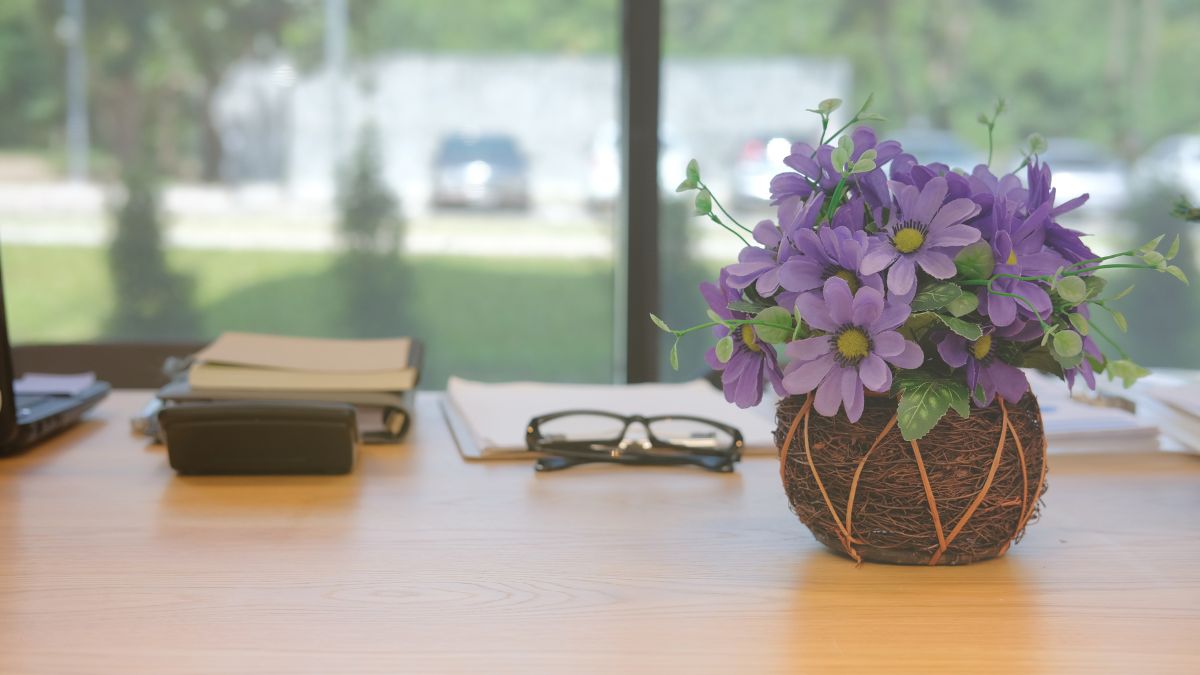Artificial plants provide many decorating benefits–reliability, little to no maintenance, and in many cases, constant color. However, some of these foliage alternatives play up the “artificial” and overshadow the “plant.”
While there are times when faux flowers and plants can convincingly perk up an interior or add a vintage vibe to a room, they are not the only substitute for lavish fresh bouquets. Variety-seekers should know that affordable, natural options are out there, and they can bring an unexpected yet genuine flair to your decor.
Photographs at the very end of this article provide visual aides for several of the suggested techniques that follow. Here are four ways to bring the outdoors in without resorting to silk or plastic:
Dried Flowers
A variety of dried flowers lend themselves to prominent displays. Tried and true favorites include lavender, eucalyptus, amaranth and statice.
Sometimes dried blooms are tinted with color for a vibrant effect. Purists may cringe when the dye departs from the plant’s original color, but some may find this departure to be an interesting update. Others may enjoy tints that are close to the plant’s natural blush.
Dried bunches are not limited to rustic decor; they compliment a variety of design styles. Poppy pods, globe thistle and yarrow are unusual selections that add a modern touch when encircled in a clear cylinder vase, as shown in the photograph above.
Natural Seasonal Items
Do not underestimate the appeal of seasonal arrangements. Not only is their celebration of the present immediately enticing, but the abundance of these items in stores makes the selection fabulous and the price reasonable.
Lemons evoke crisp, summery associations. A white, clear, striped or cobalt blue container filled with this economical produce makes a refreshing statement. Some lemons will keep up to two weeks, and they can even continue their starring role on your table after they dry out and turn golden. To keep the entire collection fresh, toss any lemons that begin to mold.

Pumpkins, gourds and squash are lovely autumn table toppers. For an updated look, juxtapose produce in unexpected colors, such as light yellow, peach and dark green shades of squash. Sticking to one color, as with a spread of white pumpkins in various sizes, can be an equally powerful strategy.
Pine cones enhance winter centerpieces, and they are often sold in inexpensive bunches. They can fill the gaps of a beloved holiday grouping or take center stage in a festive container. For a flourish that is both retro and elegant, mix pine cones with glass ornaments in a metal bowl.
Spring returns the color green to the outdoors. Featuring this tone indoors is a great way to mark the return of warmer weather and new blooms. A trek to the flower shop is not necessary for this tactic; decorate by using what you have. Nearby greenery may include trimmings from houseplant grooming sessions, clippings from your yard, or culinary herbs, such as parsley and basil, that can be stored in bud vases rather than the refrigerator.
Rocks and Seashells
Unpack and display rock and seashell collections to create the ambiance of a curiosity shop. If pieces are not to your liking and nearby treasure-hunting sites are scarce, local craft stores can be an inexpensive source for these items.
Rock and mineral specialty shops often sell specimens, such as moss agate, by the pound. Science museum gift stores also offer a variety of noteworthy samples, such as amethyst and geodes. Beach souvenir shops feature large shells for less-than-large prices. Garage sales and the internet are two additional sources for earthy bargains.
Highlight collection favorites by placing them in apothecary jars, either in groups or individually. A single sea urchin shell in a clear, lidded container is both simple and unusual, while filling receptacles to the brim achieves a look of sleek abundance.
Potted Plants
If you are open to a bit of maintenance but don’t want the hassle of regular trips to the florist, the one-time expense of purchasing a potted plant makes this option cost-effective. Tired of the all-too-familiar Aspidistra, also known as the cast iron plant? Try some eye-catching yet hardy selections that will give your space a conservatory-like atmosphere.
While commonly used as houseplants, ferns are unique in their ability to appear both untamed and contained at the same time. Boston ferns are often seen hanging in baskets on front porches, but if placed on a table or stand in a bright indoor spot, they can be a dramatic focal point to any room.
Bird’s nest ferns boast glossy fronds whose curved positions imply movement. These plants can be kept in smaller pots and require medium light levels, increasing placement options as long as sunlight filters through nearby windows.
Zamioculcas zamiifolia, also known as the ZZ Plant, is gaining popularity due to its exotic appearance and low-maintenance properties. This plant can thrive indoors, tolerate a variety of lighting conditions and give any room a tropical look. The ZZ Plant has also been called pest-resistant, as its shiny leaves seem to attract few insects.
Combine to Create
Using natural items to embellish your home cuts costs without cutting creativity and produces truly striking results. Don’t hesitate to combine your favorite techniques. For example, group several small houseplants in a larger pot filled with soil, then add a quartz specimen and one or two seashells to create a powerful vignette.
Let the natural world around you be your inspiration, and don’t be surprised if you begin to notice many unexpected uses of everyday items.
- Key Strategies to Mitigating risks in Rental Property Investments
- The Essential Role of Property Management Companies
- The Ultimate Guide to Handling Evictions and Tenant Conflicts
- The Hidden Impact of Taxes and Insurance Costs
- Protect Your Property: Essential Practices for Effective Tenant Screening

